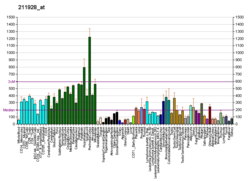Clinical relevance
Defects in axonal transport, of which dynein plays a key role, have been implicated in conditions ranging from developmental defects in the brain to neurodegenerative disease. [9] Mutations in the DYNC1H1 gene have been associated with epilepsy, neuromuscular disease, brain malformations, intellectual disability, autism, and neurodegenerative diseases. [12] These as a whole are considered to be DYNC1H1-Related Disorders [12] or dyneinopathies. [13] Recent data implies that DYNC1H1-Related Disorders should be considered progressive, though the trigger and symptoms of that progress vary from patient to patient. [12] As of September 1, 2024, nearly 1900 gene variants have been identified and classified as either pathogenic, likely pathogenic, or variants of unknown significance. [14] The vast majority of these are missense mutations. Due to a high degree of pleiotropy, the genotype-phenotype spectrum is still developing. [15] Given the heterogeneity of symptoms, large gene size, and the high conservation of the gene, [16] it is likely that many patients remain undiagnosed. In recent larger cohort studies, the average age of patients was only 12 years old, likely due to symptoms overlap with other disorders like cerebral palsy and idiopathic autism and intellectual disability. [12]
Prior to genetic testing, clinical diagnoses for these symptoms range from Charcot-Marie-Tooth disease [17] as well as spinal muscular atrophy with lower extremity predominance 1 (SMA-LED1). [18] Another symptom is Autosomal dominant non-syndromic intellectual disability. [19] DYNC1H1 gene variants have been increasingly correlated with Amyotrophic lateral sclerosis, [20] [21] malformations of cortical development, and seizure disorders. [22] It is estimated that roughly 40% of patients with DYNC1H1 gene variants have epilepsy, and 80-92% of those with DYNC1H1-related epilepsy have malformations of cortical development, including both lissencephaly and polymicrogyria. [22] [23]
This page is based on this
Wikipedia article Text is available under the
CC BY-SA 4.0 license; additional terms may apply.
Images, videos and audio are available under their respective licenses.





